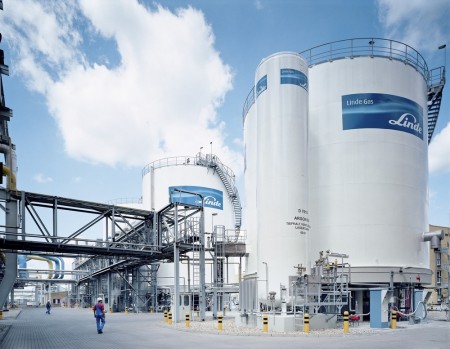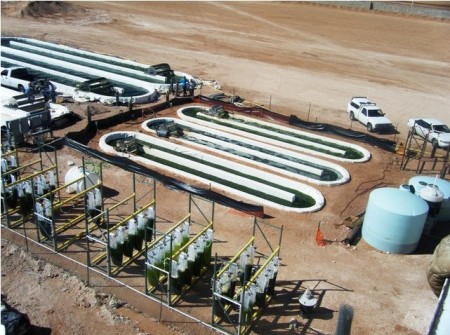May
31
A Big Industrial Move For CO2 to Algae
May 31, 2011 | 1 Comment
The Linde Group is currently the leading supplier of CO2 in the U.S., providing CO2 for processes like dry-cleaning, welding gases and cooling food products. Linde is an industry leader that employs about 48,000 people and earned nearly $18 billion in the gases and engineering sector in 2010.
The goal of the project is cut the costs of delivering anthropogenic (power plant emitted) CO2 to Sapphire’s open ponds. While waiting for the multiyear agreement to develop a commercial-scale system, Linde will provide CO2 at Sapphire’s Columbus, N.M., demonstration facility.
Linde already has substantial experience. In the Netherlands, Linde has created a CO2 delivery system that supplies 550 greenhouses with CO2 through a 100-kilometer (62 mile) pipeline from a nearby refinery. Aldo Belloni, a member of the executive board of Linde AG said, “Producing fuel by algae using CO2 from large emitters like power stations and chemical plants is a very promising way of reducing greenhouse gas emissions.”
Linde’s projections suggest a single commercial algae-fuel facility will require roughly 10,000 metric tons of CO2 per day. With the need for fuel dependency becoming clearer, according to Cynthia Warner, president of Sapphire Energy, “we need great partners who can supply sufficient and low-cost access to CO2.”
Linde, Warner believes, has a great understanding of efficiently managing the distribution process of CO2, adding that with this collaboration, Sapphire is moving “closer to delivering a domestically produced, cost-efficient source of algae-based green crude.”
The partnership between Sapphire Energy with a billion dollar company isn’t the first major coup for the algae developer. In March, Sapphire also partnered with Monsanto to develop algal genes that might apply to Monsanto’s work in agriculture.
The attraction for Linde would be Sapphire Energy has developed technology to produce a renewable and low-carbon substitute for fossil-based crude oil. Sapphire’s green crude produces drop-in fuels — jet, diesel, and gasoline — that are said to be compatible with existing infrastructure and engines.
Sapphire’s algae are grown in salty, non-potable water, using lands not suitable for agriculture, and require only sunlight and CO2 to grow — all sustainable features that petroleum and most other biofuel options cannot match, says the company. The technology represents an approximate 70% reduction in lifecycle carbon emissions compared to petroleum-based equivalents.
This news is plainly significant as Linde is a very large industrial gas supplier with extensive financial resources, engineering expertise and experience in customer support. This puts comparably tiny Sapphire in a leading role. It also suggests an endorsement of sorts that Sapphire’s algae technology has real legs for getting to market for a profit.
With an armada of small firms looking for an algae solution, Linde could fairly be expected to have checked into the technology very deeply before signing on to a multi year, capital intensive, and engineering demanding role.
That says a lot about algae’s progress – the idea that algae companies are still very far away from commercial operation at scale is falling behind now.
The algae business hasn’t make much breakthrough news of late. This news though is better than news from research; it’s an investment out of the lab on the ground, going to production and consumer sales. Seeing a Linde caliber company leading is very encouraging and assures that other algae firms will have opportunities as well.
What isn’t revealed are the parameters Linde used to support its decision to proceed. Those data points would be of intense interest for an entire industry. For certain, the plan is for Linde to earn on its investment supplying the CO2 to Sapphire. That implies that Sapphire has the customers lined up to take the products.
The Linde and Sapphire agreement is a milestone event. Lets hope it’s just the first one of many more to come soon.
Comments
1 Comment so far




Sounds like an interesting technology which could reduce the CO2-emissions and produce biomass (bioenergy?) at the same time.
I heard of a project close to my hometown Berlin (Germany), where a power plant also started a partnership with an algae production facility, but it was just a small-scale demonstration plant.
The discussions around the carbon capture and storage technology (CCS) could find a good partner in these efficient concept. I think it is much better and sustainable to use the carbon dioxide immediatly again, instead of storing it deep in the earth.
Thanks for the article!